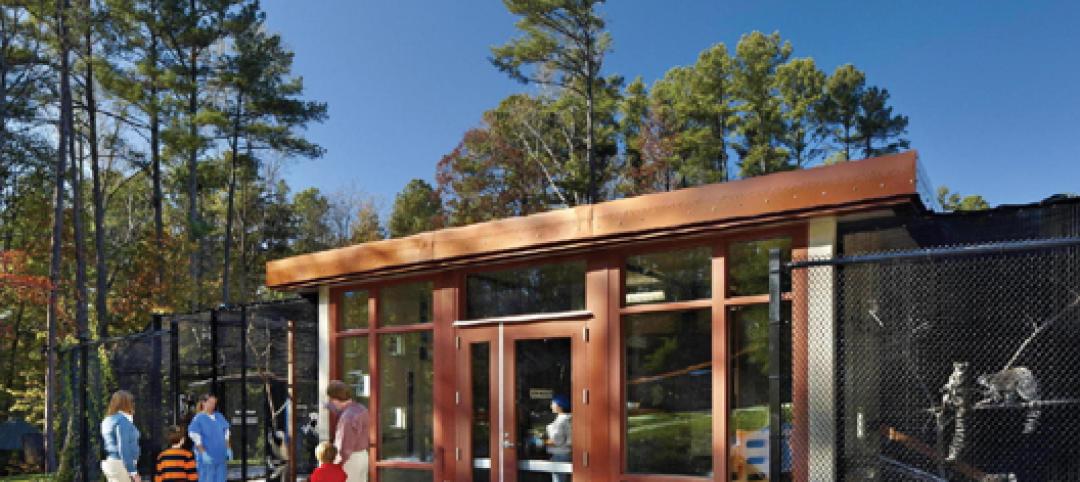After nearly half a century of use, Southminster Presbyterian Church’s steel window frames and single glass pane windows were in deplorable condition.
“About all they did was keep the rain and snow out but they let in all the heat and all the cold all of the time,” said the Rev. Dr. Daniel B. Merry, senior pastor, Southminster Presbyterian Church in Mt. Lebanon, a Pittsburgh suburb.
New windows would need to not only stand the test of time, but also accommodate the aesthetics of an architecturally historic church. The Norman Gothic style church was originally designed by renowned architect Thomas Pringle and built in 1928. An additional wing for educational programs and offices was added in the early 1950s. The educational wing includes the approximately 350 steel frame windows that needed to be replaced.
After receiving several bids from different companies, the Rev. Merry and Southminster Presbyterian Church chose GThurm windows from Graham Architectural Products.
“We thought GThurm windows were the best insulating window, and far superior to aluminum windows and their insulation value,” said the Rev. Merry. “We believe it is cutting-edge technology. We’d rather be on the front of the curve than the back of the curve.”
Graham Architectural Products’ GThurm high-efficiency windows are the first American-made, architecturally rated windows (AW) to feature thermal transmission measures as low as U 0.15 (R 7) using readily available insulating glass. The window lineals, which were created using the G2RP glass-reinforced polyurethane pultrusion process, offer improved dimensional stability, durability, thermal insulation and environmental friendliness over traditional windows. The polyurethane used to produce G2RP reinforced glass fibers is a unique polyurethane resin supplied by Bayer MaterialScience LLC that contains no volatile organic compounds (VOCs). Graham Architectural Products is a member of Bayer’s EcoCommercial Building (ECB) Network that strives to make net-zero energy buildings possible by bringing together leading companies that provide state-of-the-art product and service technologies.
“One of the primary benefits of the GThurm material technology is the lack of heat conduction,” said Jim Eisenbeis, director of marketing, Graham Architectural Products. “Aluminum is 700 times more heat conductive than our material, which is bad if you want to keep heat in or out of the building.”
Harry George, manager, new markets, Bayer MaterialScience LLC, said: “In this project, replacing the window frames alone provides significantly better thermal conductivity than the old steel frames. The GThurm product provides a more energy efficient window than a thermally broken aluminum window, or a steel frame window.”
Gibsonia, Pa.-based Windows Systems Inc. removed the old windows and installed the new models. The steel casement windows, originally installed with a fin that goes between the exterior stone and interior block wall, required an elaborate removal process, said Drake Core, vice president, Window Systems Inc.
One of the most important challenges was retaining the sight lines of the building even as the church requested a reduction of operable windows with fixed windows.
“This created a sight line issue,” Core said. “If one window opens and another one doesn’t, that affects the look from the outside due to the differing thickness. We downsized the fixed window and added to it so that it replicates an operable window and maintains a uniform appearance.”
Additionally, the presence of an on-site daycare facility required the installers to meet federal “renovate, repair, paint” regulations for lead paint. Core and his team went a step further and hired an outside consulting firm to monitor air quality and surfaces during and after the installation.
With those challenges solved, the installation of the new windows was cut and dried, he said. “It’s pretty much the same installation process as traditional aluminum windows,” Core said.
The newly installed windows offered an unexpected benefit for those who work in the church offices. The church is located at the corner of a busy main street and a cobblestone road. Two elementary schools and an emergency services department with a loud siren are also nearby. As such, the ambient neighborhood noise was often evident to people inside the church.
“After the project was completed, the first thing I noticed was the sound,” said the Rev. Merry. “The GThurm windows are so tight and well insulated that the quiet in the office and educational areas was immediately noticeable.
“And when the heat index soared to higher than 100 degrees for several days during a July 2011 heat wave, the offices with air conditioning units absolutely stayed cooler with the new windows than they had with the previous steel casement windows.”
Additionally, the windows provide not only improved insulation value but also superior strength. This is achieved through a pultrusion process in which 80 percent continuous stranded glass content is combined with 20 percent resin to produce window lineals, Eisenbeis explained.
Polyurethane chemistry offers many benefits over the chemistries traditionally used in the pultrusion process. Not only can polyurethane chemistries be customized on a project-by-project basis to provide greater strength, as well as better working and performance characteristics than polyesters, vinyl esters and epoxies; polyurethane resins are also free of the hazardous styrene emissions common to polyesters and vinyl esters.
Unlike traditional fiberglass window lineals, the GThurm window lineals pultruded with the G2RP require no additional reinforcement for structural integrity. The unique process allows for lightweight framing with superior structural performance and a thermal performance nearly triple that of ordinary architecturally-rated window products. The production of GThurm lineals is expected to use less energy per pound of raw materials than comparable aluminum designs, supporting a sustainable design.
“As government regulations ratchet up requirements for window insulation values, it will be increasingly difficult to install aluminum windows and meet requirements,” said Core. “The Southminster Presbyterian Church project demonstrates the viability of this new window technology.” +
Related Stories
| Jan 27, 2011
Perkins Eastman's report on senior housing signals a changing market
Top international design and architecture firm Perkins Eastman is pleased to announce that the Perkins Eastman Research Collaborative recently completed the “Design for Aging Review 10 Insights and Innovations: The State of Senior Housing” study for the American Institute of Architects (AIA). The results of the comprehensive study reflect the changing demands and emerging concepts that are re-shaping today’s senior living industry.
| Jan 25, 2011
Bloomberg launches NYC Urban Tech Innovation Center
To promote the development and commercialization of green building technologies in New York City, Mayor Michael R. Bloomberg has launched the NYC Urban Technology Innovation Center. This initiative will connect academic institutions conducting underlying research, companies creating the associated products, and building owners who will use those technologies.
| Jan 25, 2011
Top 10 rules of green project finance
Since the bottom fell out of the economy, finding investors and financial institutions willing to fund building projects—sustainable or otherwise—has been close to impossible. Real estate finance prognosticators, however, indicate that 2011 will be a year to buy back into the real estate market.
| Jan 25, 2011
Chicago invented the skyscraper; can it pioneer sustainable-energy strategies as well?
Chicago’s skyline has always been a source of pride. And while few new buildings are currently going up, building owners have developed a plan to capitalize on the latest advances: Smart-grid technologies that will convert the city’s iconic skyline into what backers call a “virtual green generator” by retrofitting high-rise buildings and the existing electrical grid to a new hyper-connected intelligent-communications backbone.
| Jan 25, 2011
AIA reports: Hotels, retail to lead U.S. construction recovery
U.S. nonresidential construction activity will decline this year but recover in 2012, led by hotel and retail sectors, according to a twice-yearly forecast by the American Institute of Architects. Overall nonresidential construction spending is expected to fall by 2% this year before rising by 5% in 2012, adjusted for inflation. The projected decline marks a deteriorating outlook compared to the prior survey in July 2010, when a 2011 recovery was expected.
| Jan 25, 2011
Jester Jones Schifer Architects, Ltd. Joins GPD Group
GPD Group is excited to announce that Jester Jones Schifer Architects, a Marion-based architectural firm, has joined our firm, now enabling GPD Group to provide architectural services to the Central-Ohio market.
| Jan 21, 2011
Combination credit union and USO center earns LEED Silver
After the Army announced plans to expand Fort Bliss, in Texas, by up to 30,000 troops, FirstLight Federal Credit Union contracted NewGround (as CM) to build a new 16,000-sf facility, allocating 6,000 sf for a USO center with an Internet café, gaming stations, and theater.
| Jan 21, 2011
Manufacturing plant transformed into LEED Platinum Clif Bar headquarters
Clif Bar & Co.’s new 115,000-sf headquarters in Emeryville, Calif., is one of the first buildings in the state to meet the 2008 California Building Energy Efficiency Standards. The structure has the largest smart solar array in North America, which will provide nearly all of its electrical energy needs.
| Jan 21, 2011
Primate research facility at Duke improves life for lemurs
Dozens of lemurs have new homes in two new facilities at the Duke Lemur Center in Raleigh, N.C. The Releasable Building connects to a 69-acre fenced forest for free-ranging lemurs, while the Semi-Releasable Building is for lemurs with limited-range privileges.










